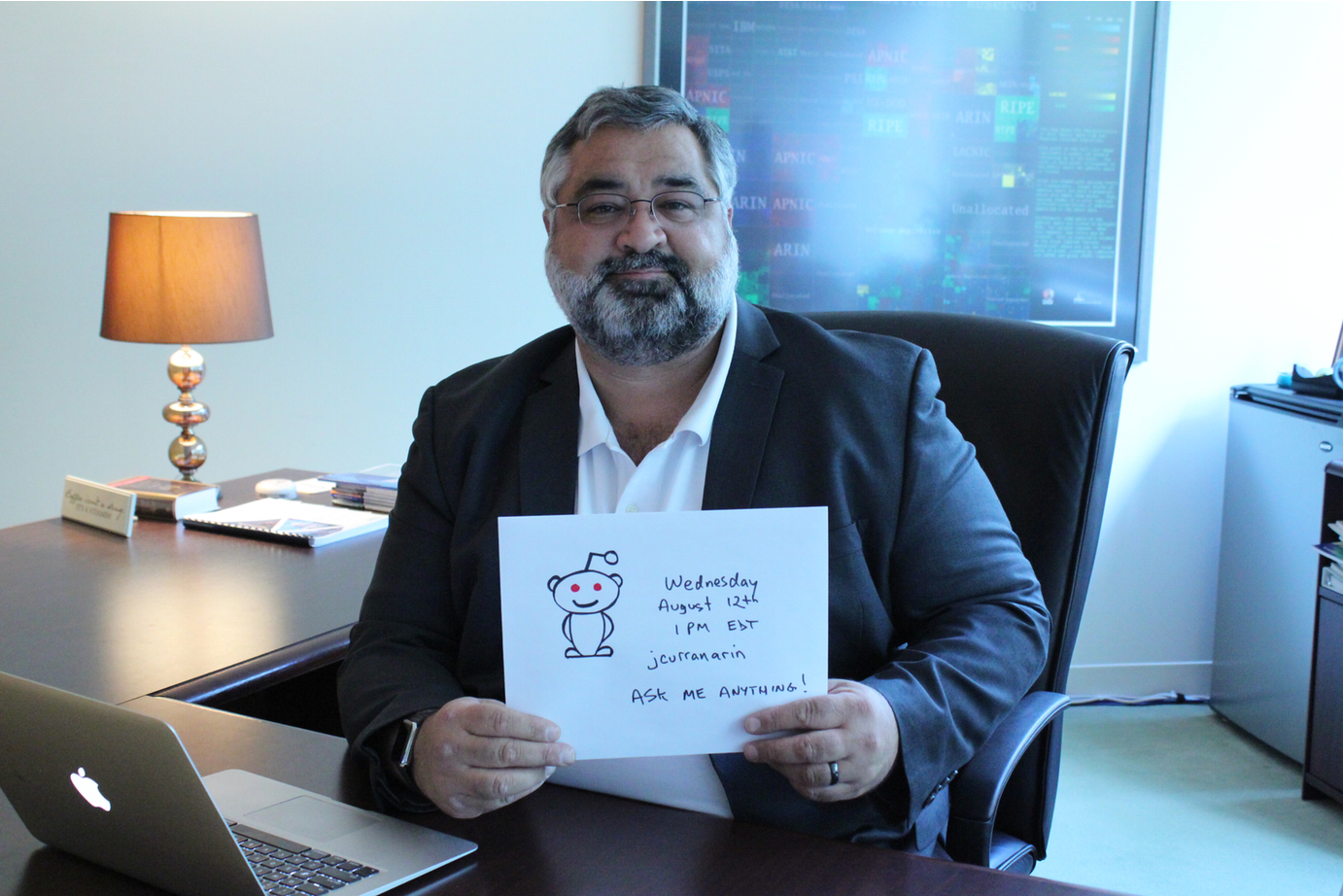
Top 6 Reddit AMA Questions with ARIN CEO [Archived]
OUT OF DATE?
Here in the Vault, information is published in its final form and then not changed or updated. As a result, some content, specifically links to other pages and other references, may be out-of-date or no longer available.
With opening his computer, removing his watch, and stretching his fingers, ARIN’s President and CEO John Curran prepared to type. And type he did! Last Wednesday, John hosted a Reddit Ask Me Anything (AMA) session to raise awareness of the need for IPv6 deployment as we rapidly approach IPv4 address runout. He answered questions on topics ranging from the effects of IPv4 depletion on various Internet stakeholders, to IPv6 migration tools, and let’s not forget coffee! In case you missed the AMA, here are the top six questions (as voted on by those who participated) and his speedily typed answers –

Q: Would you rather fight an IPv4-quantity of horse-sized ducks or an IPv6-quantity of duck-size horses?
A: An IPv6 quantity of anything is lethal… gimme the 4.b billion horde of huge ducks, and perhaps something sharp to wield!
Q: IPv6 is clearly the direction we want to be heading, but the allocation and assignment policies people are deploying will probably mean we’ll end up with a HUGE table size which will even further constrain resources in ASIC driven routers. What is ARIN (and the other RIRs) doing to try and prevent needless deaggregation of prefixes into the DFZ?
A: It’s a real problem - in the short term, we need to accommodate both the IPv4 and IPv6 tables in parallel, and things are going to get tight. I’m not actually worried about the IPv6 routing table (even though each entry can be larger in size) because the number of issued IPv6 blocks is still likely to be quite small compared to the decades of IPv4 address issuance.
However, IPv4 is going to be a big problem in the interim, as parties start valuing unique public addresses and don’t really care about the minimize size… i.e. if you can acquire a /28 and have a unique presence on the Internet, why pay more to get a /24? In the end, it’s going to be up to the ISPs to decide what is the minimum size “customer Bring-Your-Own-Address (BYOA)” that they’re willing to route…
Q: What is your favorite drink, and why is it coffee?
A: In the morning, coffee. Lot’s of coffee - I prefer fresh latte or expresso, but will drink nearly anything caffeinated at 5 AM. In the middle of the day, more coffee. At night, more coffee, and an occasional gin and tonic or expresso martini (see a pattern here?)
Q: Is there any sort of plan for reclaiming the unused portions of the /8s and such that big companies bought up in the beginning?
A: We’ve actually been reclaiming unused IPv4 space for a while, with some very good results. We would have run out years sooner, if it were not for organizations such as BBN, the US DoD, Stanford, Interop, and others who returned unneeded address space as a result of these efforts. You can read more about that here - https://www.icann.org/news/blog/recovering-ipv4-address-space
Two important things to keep in mind - 1) we were issuing IPv4 space in 2010 and more than 10 /8’s per year, so recovering another handful doesn’t change IPv4’s outlook in the least, 2) this is further shown by IPv4’s 4.3 billion total address space compared with 7+ billion people on the planet… we literally can’t provide for one always-on device for everyone here via IPv4 (let alone their home, work, cloud, etc. demands)
Q: What do you see happening once the “official” source of IPv4 addresses run dry? I’ve heard speculation about black markets and prices for IPv4 addresses skyrocketing etc, what’s your take? As for IPv6, are there currently any big hurdles standing in the way of rapid, worldwide adoption? Any technical challenges? Or perhaps security related?
A: While black market transfers are possible, the reality is that we already have today an IP transfer market which is working well, and completely legitimate. Folks that wish to transfer addresses can do so, both within the ARIN region, and to/from other regions in accordance with policy. Given that, there’s not a lot of reasons to try and work around the legitimate transfer process, unless you are trying to bypass the policies, and the risk one takes is that nearly anyone can sell repeatedly to multiple buyers if they’re not going to update the registry… not a reasonable risk that most businesses will take.
Q: As someone who was not even aware that we are running out of IPv4 addresses how will this affect me and what will be different with IPv6 compared to IPv4?
A: I do hope you are not an Internet Service Provider and just hearing about this now. If that’s the case, my advice is to change professions quickly. ;-) Otherwise, if you’re just a typical organization, it’s good to know that many of the folks accessing your website today are coming over mobile devices that actually connected to the Internet via a slightly different protocol (i.e. IPv6) Your website is likely connected only via IPv4. This should be remedied as it will provide for more direct connections with better performance, and really is not much work. Talk to your IT department (or if you are the IT department, then go online to [teamarin.net/get6](http://www.teamarin.net/get6) and then talk to your hosting company or ISP).
Thanks to all of you Redditors who submitted questions. To view the entire exchange, check out the whole conversation over on the IAmA subreddit. There were lots of interesting questions and answers you won’t want to miss. Best of all? We can sigh a breath of relief that we dodged that lethal IPv6-quantity of duck-size horses.
OUT OF DATE?
Here in the Vault, information is published in its final form and then not changed or updated. As a result, some content, specifically links to other pages and other references, may be out-of-date or no longer available.
